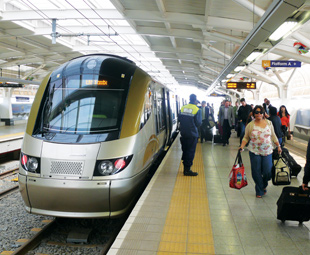Bouquets and brickbats for public transport

Udo Rypstra made use of public transport to get from Randburg to Cape Town and back, using taxis, buses, the Gautrain and SA Airways in the process. He came away impressed with the Gautrain and BRT bus services, but has some brickbats along with the bouquets for the taxi industry
It started off as a joke, and then it became a R100 bet: I was dared to travel by public transport from Randburg, Gauteng, to Tableview, near Cape Town, and back. This counted in SA Airways as a supplier of public transport, and using minibus and metred taxis, the Gautrain, the bus rapid transport and metrobuses on the ground.
What led to the dare was a discussion around a barbeque in Randburg about all the positive public comments on the Internet about SA public transport after the staging of the World Cup. I had put out Google Alerts on the Internet to pick up such comments and, almost without exception, they were full of praise for the Gautrain and BRT system, but for the rest, aikona. Metrobus services were unreliable, metred taxis were a rip-off and minibus taxis were dangerous to use. Are they?
Mercedes-Benz provided the reason to go to Cape Town. It had military trucks on show at the Aerospace and Defence Show at Ysterplaat airbase and I called my sister in Tableview to let her know I was popping in for the weekend. No need to pick me up at Cape Town International because I had all my logistics worked out to make it by public transport.
I live about 3 km from M-Net’s studios in Randburg and I departed from my abode on a Friday morning in September, with a small suitcase on wheels containing my camera, my laptop and a few changes of clothing. I hailed a minibus taxi (R7) travelling into Randburg, thinking I would catch the Gautrain feeder bus (R20) to the Sandton Gautrain station.
Lesson Number One: I learned you have to buy a Gautrain smart card ticket at a Gautrain station first, before you can use the feeder bus, so instead I hailed another taxi (R11.50) at the Randburg taxi rank to Alexandria that dropped me halfway in Grayston Drive, about a 10-minute walk to the station.
From there, I bought a Gautrain smart card, loaded it with R300 in cash and took the train (R100) to OR Tambo International Airport.
I have travelled on all sorts of trains before – in London, Amsterdam, Rotterdam and even the Metrorail that runs between Cape Town and Bellville in the Cape. But this 15-odd minute experience, my first on the Gautrain, was certainly the most exhilarating of all, although, at R100 (one way), a trifle expensive.
Four hours after my depar ture from home I landed at Cape Town International where, for another R50, I made use of the brand new Scania BRT bus service to Cape Town’s Civic Centre near the Grand Parade.
ture from home I landed at Cape Town International where, for another R50, I made use of the brand new Scania BRT bus service to Cape Town’s Civic Centre near the Grand Parade.
From there, I could have taken a Golden Arrow bus out Milnerton way, but knew there was a taxi rank at the Bayside Shopping Centre in Tableview so decided to make use of that service from the Grand Parade. And voila! Another hour or so later I was having a beer with friends at the Tableview Soccer Club near the shopping mall while waiting for my sister to come home from work. And she lives just around the corner.
The return trip was different. On Monday, I was dropped off at Ysterplaat by my sister on her way to work and after spending the day inspecting all the military goodies, Mercedes-Benz took us by Avis-Rent-A-Sprinter and dropped us off at the airport.
Back at OR Tambo International Airport, I used my Gautrain card to first catch the train back to Sandton station (another R100) and then a shiny Mercedes-Benz Gautrain feeder bus (R20) which dropped me off almost on M-Net’s doorstep.
It was only then, standing there in the dark with my mobile suitcase and thousands of rands of equipment in it that I got cold feet.
It was about 9pm and there were no taxis coming past. What if I got robbed on the last few kilometres home?
That’s when I phoned a friend … and lost my bet.
I have been without a car for a while and just for the challenge (and being able to write this story) I have been taking more informal taxis to various locations in and around Johannesburg, Midrand and Randburg.
For example, to attend the recent NEPAD conference at Gallagher Estate, I made use of informal taxis only. The fare from Randburg to the Midrand taxi rank, which is virtually next door to Gallagher Estate, is only R11.50.
The fare to Johannesburg from Randburg is only R7 and on this occasion I got dropped off in front of the University of Johannesburg to attend a meeting of the Transport Forum Special Interest Group (SIG). I took another black taxi back, also for R7.
It is by using informal taxis that I learned more lessons.
Lesson Two is that the antiquoted phr ase, “black taxi”, has become a misnomer. Everybody has started using them, whites, Indian, Chinese, students, office workers, pensioners, etc; people from all walks of life, some of them dressed poorly, but most of them well-dressed, reading novels or playing around with their smartphones. They may not have PCs at home, but the smartphone appears to be rapidly replacing the cellphone.
ase, “black taxi”, has become a misnomer. Everybody has started using them, whites, Indian, Chinese, students, office workers, pensioners, etc; people from all walks of life, some of them dressed poorly, but most of them well-dressed, reading novels or playing around with their smartphones. They may not have PCs at home, but the smartphone appears to be rapidly replacing the cellphone.
Lesson Three: Sign language is needed only on routes shared by taxis for a kilometre or two and then branching off in different directions. There are hundreds of taxis running up and down during peak times and that’s when you need it. But on long routes in between peak times you just point your finger in the direction you want to go.
Lesson Four: Don’t sit next to the driver unless you don’t mind becoming a bus conductor. You end up with all the money being passed from the back to the front and you are responsible for checking whether everyone has paid up. The driver will hold you responsible for that.
Lesson Five: If you know you are getting out first, get on board last. It’s very awkward for everyone to have to get out, allowing you to come out from a backseat.
Lesson Six: Try to have the correct amount. Once I was caught with only a R100 note on me and the driver had to stop at a petrol station to get change. Fellow passengers gave me such a look that I felt like a fool. On another occasion, the driver had to stop another taxi at a robot to get change. Judging from all the hooters going off, motorists behind us were not amused.
Lesson Seven: Pray for your life. These guys can drive fast. No seatbelts, no indicators, and it’s lane swopping all the way. That’s why few passengers talk to one another on the way to their destination.
They’re praying that they will survive the journey.
Published by
Focus on Transport
focusmagsa



